Different Types of Cleats: Baseball vs. Football vs. Soccer + More
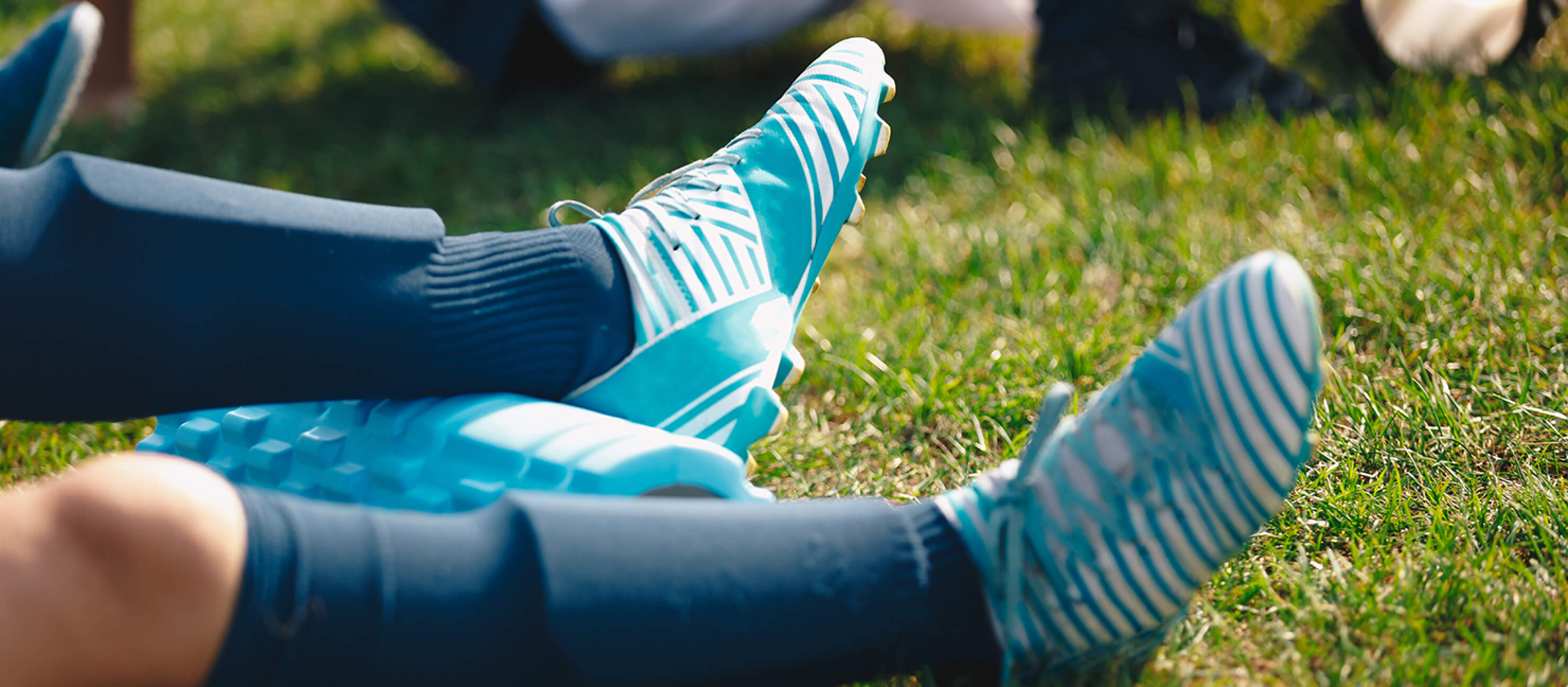
Do you know about the different types of cleats? Learning about the differences between all of them can not only spare you (or your child) from unnecessary injuries. You can also end up saving so much time and money!
It shouldn’t surprise you to hear that each sport requires its own separate cleat. Even individual or local leagues within each sport can have their own special regulations. By reading this guide, you’ll walk away understanding everything you need to know about how to choose the best cleat for your unique needs.
What Are Cleats?
Cleats are a type of athletic shoe that has studs (also known as spikes) on the sole to help grip the playing surface. They can differ based on spike shape, spike material, the height of the cut (where the upper part of the shoe hits your ankle), and the overall weight of the shoe. Athletes in baseball depend on different features than soccer or football. That’s why there are so many variations.
Cleat Material
The actual cleat (often called the spike or stud) shape and material have the biggest impact on your traction and maneuverability on the field. Cleat material is typically classified as the following:
-
Metal: Most common at the professional level due to safety precautions; typically used for golf, track and field, baseball, and soccer (although some referees may not allow them); can be detachable
-
Molded: The sole of the shoe is covered in pre-made studs permanently fixed; made of flexible-yet-durable rubber; great for youth sports; good for a variety of playing surfaces; safe and comfortable
-
Plastic: Made from hard plastic (like TPU); resemble molded cleats; offers excellent friction and durability; lightweight
-
Detachable: Has studs that can be changed and replaced; offers versatility; highly customizable for specific types of playing surface

Cleat Height
-
Low-cut: Below the ankle, offers minimal ankle support; best suited for agility and speed
-
Mid-cut: Offers moderate ankle support; doesn’t sacrifice agility and speed
-
High-cut: Hits above the ankle; offers the best ankle support; good for players with injuries
Cleat Length and Shape
The length of the cleat affects the grip your cleats will have. Shorter studs are best for playing on dry ground. Longer studs are used on the wet ground where they can dig into the turf and give the athlete better traction — typically available in four lengths (½ inch, ⅜ inch, ¾ inch, and 1 inch).
Comparing the Main Types of Cleats
Before you purchase a pair of cleats, remember to check with your league’s regulations! Things like preferred cleat length and approved materials vary between each organization. More often than not, these leagues will have their own rules to consider. Use this chart to help you understand the main differences between the types of cleats.
| Types of Cleats Comparison Chart | |||||
|---|---|---|---|---|---|
| Sport | Cleat Cut Height | Cleat Material | Cleat Weight | Intended Playing Surface | |
| Baseball | Low | Metal, molded | Lighter, heavier | Turf, grass | |
| Football | Mid, high | Metal, molded | Heavier | Turf, grass | |
| Soccer | Low | Molded | Lighter | Turf, grass | |
| Softball | Low, mid | Metal, molded | Lighter, heavier | Turf, grass | |
| Lacrosse | Mow, mid, high | Molded | Lighter, heavier | Turf, grass | |
Baseball Cleats
Baseball cleats have lower cut boot sides that are typically lighter weight. This allows for more lateral motion and traction on the diamond — not contact sports. The exact type of baseball cleat you choose will be determined by the position you play. For example, infielders need more traction so will likely choose metal cleats.

Expert Tip:
Pitchers’ cleats have a reinforced toe cleat (also known as a toe drag) to help pitchers push off of their toes. This also helps prevent wear and tear on the front part of the cleat brought on by their throwing motion.
How Should Baseball Cleats Fit?
Baseball cleats should be snug on your feet when wearing similar socks to the ones you plan on playing in. If you have enough room to comfortably wiggle your toes, you’ve found a good size.
You shouldn’t experience any sliding in your heel. Nor should your cleats be overly tight. Ill-fitting baseball cleats only result in a loss of movement on the field or possible injuries when playing.
Football Cleats
With the prevalence of turf fields, most football cleats are short (less than ½ inch) and hard-molded. Detachable cleats are best used for playing on grass. Football cleats typically have higher sides on the boot portion of the shoe for extra ankle support.

Expert Tip:
Youth players will likely need a new pair of cleats every year as their feet continue to grow. Because detachable spikes typically cost more than molded ones, parents may want to wait until their child's feet have stopped growing before investing in a detachable style. Additionally, many youth football leagues only permit molded cleats.
How Should Football Cleats Fit?
As with most cleats, football cleats should be nice and snug. The game of football demands plenty of sharp pivots, sprinting to intercept, and spontaneous stopping as you evade those incoming blocks. This tightness makes it easy to maneuver on the field. Signs it’s time to size up your football cleats include:
-
You get blisters when you wear them
-
Your feet constantly rub up against the shoe’s structure while you move
Soccer Cleats
Soccer cleats are categorized as either firm ground or soft ground. The molded studs on firm ground cleats are suitable for a variety of playing surfaces. Soft ground cleats feature fewer studs, are often detachable, and are best for playing in wet and muddy conditions.
The spikes are typically shorter to allow players to stay closer to the ground and better maintain their balance. This also helps prevent injury to other players in a collision with a high kick.
The upper part of the shoe is typically made of flexible leather for durability as the ball repeatedly comes in contact with the boot. It also allows for a better sense of touch for ball control and maneuverability for all of the running the sport requires.
You cannot play soccer while wearing baseball or football cleats. Referees typically check players’ cleats before each match.

How Should Soccer Cleats Fit?
Soccer cleats should be tighter. Tightness gives players plenty of movement, improved touch when interacting with the ball, and ample ankle stability and foot support. Think about the resulting snugness when a properly-fitting sock shapes your foot. Soccer cleats are no different! You should always have enough room to wiggle those toes or flex your feet pain-free.
Expert Tip:
Your cleats might feel stiff or a little uncomfortable for the first two practices. Blisters are always a sign your cleats are TOO tight, though. Popular brands likely have their own sizing standards. Always try on several brands and sizes at the store to ensure yours is the right fit!
Softball Cleats
Metal softball cleats are the most popular style for high school-level athletes and above. They provide the best traction on grass outfields and dirt infields.
Molded plastic softball cleats can also be worn on most surfaces and are best for soft or muddy conditions. They also offer more longevity as they do not wear down like metal cleats tend to do. The height and material can also vary by field position.

Expert Tip:
Metal cleats are not allowed on artificial pitching mounds.
How Should Softball Cleats Fit?
Most softball cleats tend to fit exactly like everyday shoes. They shouldn’t be too loose, though! Make sure your toes have enough room to wiggle around a little. The ‘right’ fit will also highly depend on you wearing the correct athletic socks normally worn on the field. So skip those everyday socks when heading to the store.
Lacrosse Cleats
Lacrosse cleats are available in different cut heights and cleat lengths to match field positions. Because metal cleats are not allowed in lacrosse, players typically use the same shoes whether they’re playing on artificial or natural grass surfaces. Lacrosse cleats also have studs outside the soles for added stability during lateral movement.

Expert Tip:
Lacrosse requires a lot of running, so choose cleats that feel the most comfortable to you.
How Should Lacrosse Cleats Fit?
Lacrosse cleats should be snug when wearing the same athletic socks you intend to play in. For players who prefer a tighter fit, go a half-size down. You shouldn’t feel any pain wearing them. If a pair makes you uncomfortable or you can feel pressure from the studs, choose a bigger size.
What’s the Difference Between Soccer and Football Cleats?
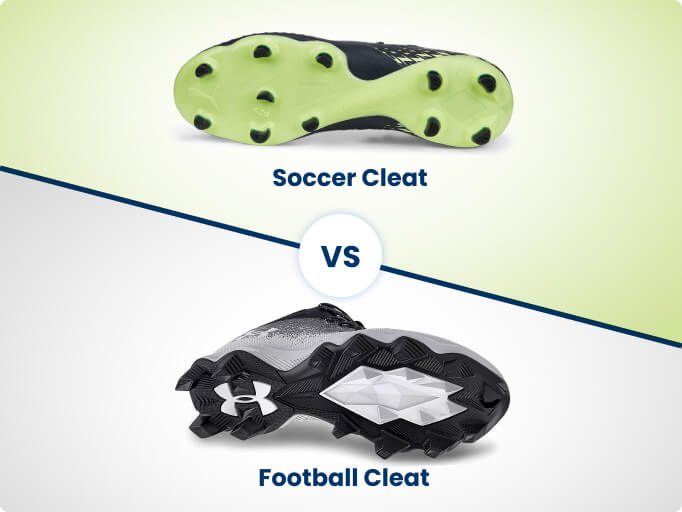
Stud Layout
- Football cleats have a spike at the toe for added traction and acceleration needed for blocking and jumping.
- Soccer cleats can be used in football and are commonly worn by kickers, who need to feel the ball on their foot.
- Soccer cleats are also great for playing flag football. You cannot, however, wear football cleats to play soccer.
Construction
- Due to the constant impact of the ball and turf during the game, soccer cleats are designed to be more lightweight, flexible, and durable than other types of cleats.
- Football cleats have more padding and support for added protection needed during play.
| Soccer Cleats vs Football Cleats Chart | |||||
|---|---|---|---|---|---|
| Soccer Cleats | Football Cleats | ||||
| Can be worn for football | Can NOT be worn for soccer | ||||
| No toe spike | Toe spike | ||||
| Low-cut | Low- to high-top cuts | ||||
| Lightweight construction | Heavier construction | ||||
| More flexible material | More padding for support and protection | ||||
| No midsole | Midsole | ||||
What’s the Difference Between Football and Baseball Cleats?
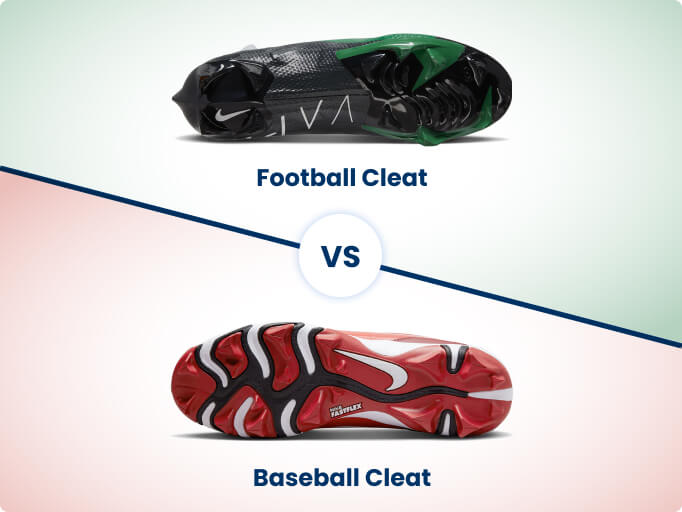
Both baseball and football cleats come in a variety of styles to suit each player’s field position. But the biggest difference between football and baseball cleats is that baseball cleats are not made for contact. They are typically made of lightweight materials, whereas football cleats’ heavier design means they can offer enhanced protection and durability while allowing plenty of movement.
| Football Cleats vs Baseball Cleats Chart | |||||
|---|---|---|---|---|---|
| Football Cleats | Baseball Cleats | ||||
| Toe spike | Pitcher typically only position with toe spike | ||||
| Low- to high-top cuts | Low cut | ||||
| Heavier construction | Lighter weight | ||||
| More padding for support and protection | Not intended for contact | ||||
| Metal and molded styles | Metal and molded styles | ||||
What’s the Difference Between Softball and Baseball Cleats?
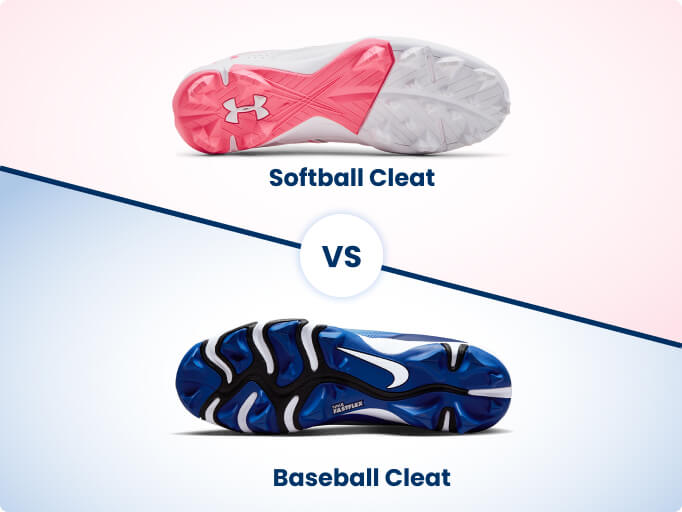
Softball and baseball have a lot of crossover both in equipment and playstyles. However, if you want to get the most out of your game, you’ll want to be aware of a few key differences. (And don’t forget to consider the different sport and league regulations for each when choosing cleats!)
| Softball Cleats vs Baseball Cleats Chart | |||||
|---|---|---|---|---|---|
| Softball Cleats | Baseball Cleats | ||||
| Rectangular cleat spikes only | Round or other shaped cleat spikes | ||||
| Smaller toe box | Wider toe box | ||||
| More available in women’s sizing | More available in men’s sizing | ||||
What’s the Difference Between Football and Lacrosse Cleats?
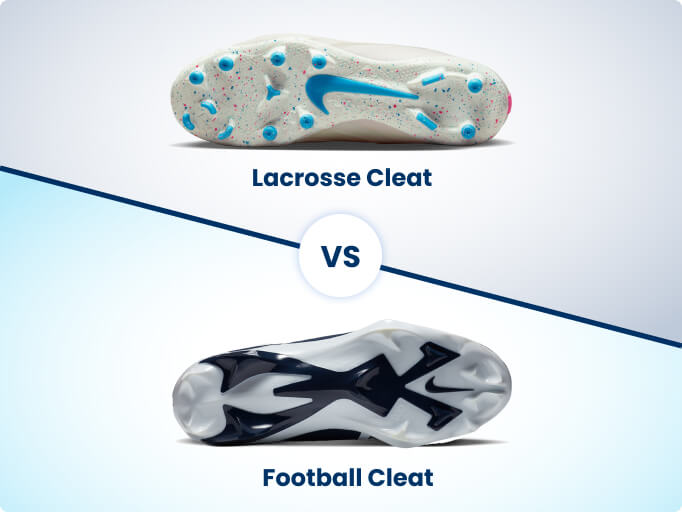
In terms of ankle support, traction, and overall weight, football cleats, and lacrosse cleats are fairly similar. If you swap sports between seasons, you may be able to reuse your football cleats during lacrosse season, but you’ll miss out on some additional functionality that can help you get the most out of your game — and vice versa.
| Football Cleats vs Lacrosse Cleats Chart | |||||
|---|---|---|---|---|---|
| Football Cleats | Lacrosse Cleats | ||||
| Most widely available in high cut for maximum ankle support | Variety of cuts for customizable ankle support | ||||
| Less breathable | More breathable | ||||
| More durable | Less durable | ||||
A Parent’s Guide To Buying Cleats for Kids
Field and diamond sports make for some of the best memories for your family — both on the field, on the sidelines, or in the stands! The one focal piece of equipment needed in these sports is a pair of proper cleats.
But some families have several kids on the field at once. Even as expenses rise, we recommend avoiding exclusively relying on hand-me-downs (either from family or friends) when possible. Cleat fit is especially important for growing kids in sports like baseball, soccer, and football.

-
Cleats offer better stability: Good stability in a properly fitted pair is the difference between preventable tumbles and slips — or even ankle sprains.
-
Cleats keep their shape: These shoes are quite rigid. An ill-fitting pair can result in unnecessary pain in your child’s foot. Always avoid cleats that are too small!
-
Spike height matters: Players under the age of 13 should have spikes no higher than a half-inch. Any taller, and your kid’s stability on the field can be compromised.
-
Slipping up when sizing up: Kids want to score — not slip. Sending children out on the field in a pair too big only results in accidental slips. Skip cleats that exceed the width of an adult’s thumb between the child’s toes and the end of the toe box.
-
Pay attention to cleat spike positioning: Children require a bit more heel support than older players. That’s why we recommend choosing a pair with a lot of cleats congregated at the heel to avoid any heel pain.
Have Fun Out There!
The most important thing to remember when shopping for different types of cleats is that the best cleats for you are the correct type for the sport and conditions you’re playing in. Properly fitted, comfortable cleats will do more for your game than anything else. If you still have questions about the different types of cleats, visit in person at an Academy Sports + Outdoors store to compare cleats and be fitted by one of our experts.